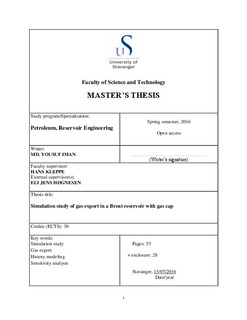| dc.description.abstract | This study reflects a simulation study of a typical Brent reservoir with gas cap. A case study has been done on Oseberg Main field, a good example of a Brent reservoir with gas cap, to understand the characteristics and the behavior of the Brent reservoir.
An analogue model ‘Beta Brent reservoir’ has been defined through the understanding of Oseberg Main field. The history of the ‘Beta Brent reservoir’ has been simulated from 1991-2016 and considered as the starting point for further drainage strategies to optimize the production from 2016-2045.
The objective of this thesis is to study the impact of different gas export strategies while maximizing the recovery of the oil. However, at first, the impact of injecting more gas on oil recovery has been analyzed and compared to a gas export case (base case). From the results, it is seen that, injecting more gas (import case) in the reservoir will not give significant oil recovery than the gas export. The oil recovery for the import case is almost the same as the base case during 2016-2035. Eventually, in 2045, the oil recovery for the import case and base case are 64.4 % and 63.01%.
Secondly, different gas export rates have been utilized to optimize the base case. Three other different cases have been defined and simulated. From the results, it has been observed that, if the gas export rate is higher, then the oil recovery factor will be lower and the ultimate recovery will be obtained quickly. Base case 3 provides higher amount of oil and gas recovery in early years than the other cases and reaches ultimate recovery of oil (62.82%) by 2030; while the base case reaches ultimate oil recovery (63.01%) in 2042.
Finally, the effect of the duration of particular gas export rate on fluid production performance has been observed. Base case 3 have been analyzed with three different gas export scenarios. From the results, it has been observed that, prolonging the duration of low gas export rate (i.e. delaying maximum gas blowdown) will increase the oil recovery and the total amount of produced gas. However, utilizing high gas export rate (i.e. early maximum gas blowdown) will reduce the oil recovery. Scenario-3 gives the higher recovery of oil (63.12%) while scenario-4 provides the minimum (62.29%). | nb_NO |
